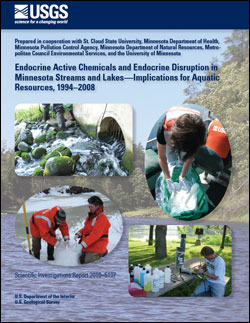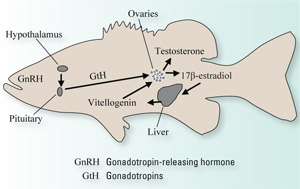Minnesota Water Science Center
CURRENT CONDITIONSCurrent streamflow conditions in Minnesota.
DATA CENTER
USGS IN YOUR STATEUSGS Water Science Centers are located in each state. 
|
Summary of endocrine-active chemicals and biological responses in Minnesota
This publication summarizes fourteen years (1994-2008) of research and monitoring of endocrine-active chemicals and biological responses in Minnesota. Endocrine active chemicals have been identified in wastewater-treatment plant effluent and surface waters downstream from discharge of wastewater-treatment plant effluent throughout Minnesota. Although concentrations are typically low, endocrine disruption has been detected in wild fish throughout Minnesota at sites downstream from wastewater-treatment plant effluent. Endocrine active chemicals and endocrine disruption have also been detected at sites with no wastewater effluent discharge indicating other potential sources. We acknowledge significant contributions to this report by St. Cloud State University, Minnesota Department of Health, Minnesota Pollution Control Agency, Minnesota Department of Natural Resources, Metropolitan Council Environmental Services, and the University of Minnesota. The report it available at the pubs warehouse.Contact: Kathy Lee Major FindingsThe U.S. Geological Survey, in cooperation with St. Cloud State University, Minnesota Department of Health, Minnesota Pollution Control Agency, Minnesota Department of Natural Resources, Metropolitan Council Environmental Services, and the University of Minnesota, has conducted field monitoring studies and laboratory research to determine the presence of endocrine active chemicals and the incidence of endocrine disruption in Minnesota streams and lakes during 1994–2008. Endocrine active chemicals are chemicals that interfere with the natural regulation of endocrine systems, and may mimic or block the function of natural hormones in fish or other organisms. This interference commonly is referred to as endocrine disruption. Indicators of endocrine disruption in fish include vitellogenin (female egg yolk protein normally expressed in female fish) in male fish, oocytes present in male fish testes, reduced reproductive success, and changes in reproductive behavior. The results from a series of studies during 1994–2008 demonstrate that endocrine active chemicals are present in Minnesota surface waters, indicating that aquatic organism exposure is likely. Endocrine active chemicals have been identified in wastewater-treatment plant effluent and surface waters downstream from discharge of wastewater-treatment plant effluent throughout Minnesota at low concentrations.  Endocrine system control of vitellogenin induction in female fish. Biological indicators of endocrine disruption have been detected in wild fish throughout Minnesota at sites directly downstream from wastewater-treatment plant effluent, indicating that endocrine active chemicals in effluent contribute to endocrine disruption in fish. This finding was confirmed in a controlled study exposing fathead minnows to wastewater-treatment plant effluent at an onsite fish exposure laboratory. During this controlled study, changes in biological responses coincided with changes in wastewater-treatment plant effluent composition demonstrating that effluent effects on fish endocrine systems are temporally variable. Although chemicals contributing to endocrine disruption in fish are complex, several laboratory studies have further confirmed that certain classes of chemicals, such as hormones and alkylphenols, which are components of wastewater-treatment plant effluent, affect the endocrine systems of fish through biochemical, structural, and behavioral disruption. Although these studies indicate that wastewater-treatment plant effluent is a conduit for endocrine active chemicals to surface waters, endocrine active chemicals also were present in surface waters with no obvious wastewater-treatment plant effluent sources. Endocrine active chemicals were detected and indicators of endocrine disruption in fish were measured at numerous sites upstream from discharge of wastewater-treatment plant effluent. These observations indicate that other unidentified sources of endocrine active chemicals exist, such as runoff from land surfaces, atmospheric deposition, inputs from onsite septic systems, or other groundwater sources. Alternatively, some endocrine active chemicals may not yet have been identified or measured. The presence of biological indicators of endocrine disruption in male fish indicates that the fish are exposed to endocrine active chemicals. However indicators of endocrine disruption in male fish does not indicate an effect on fish reproduction or changes in fish populations. |